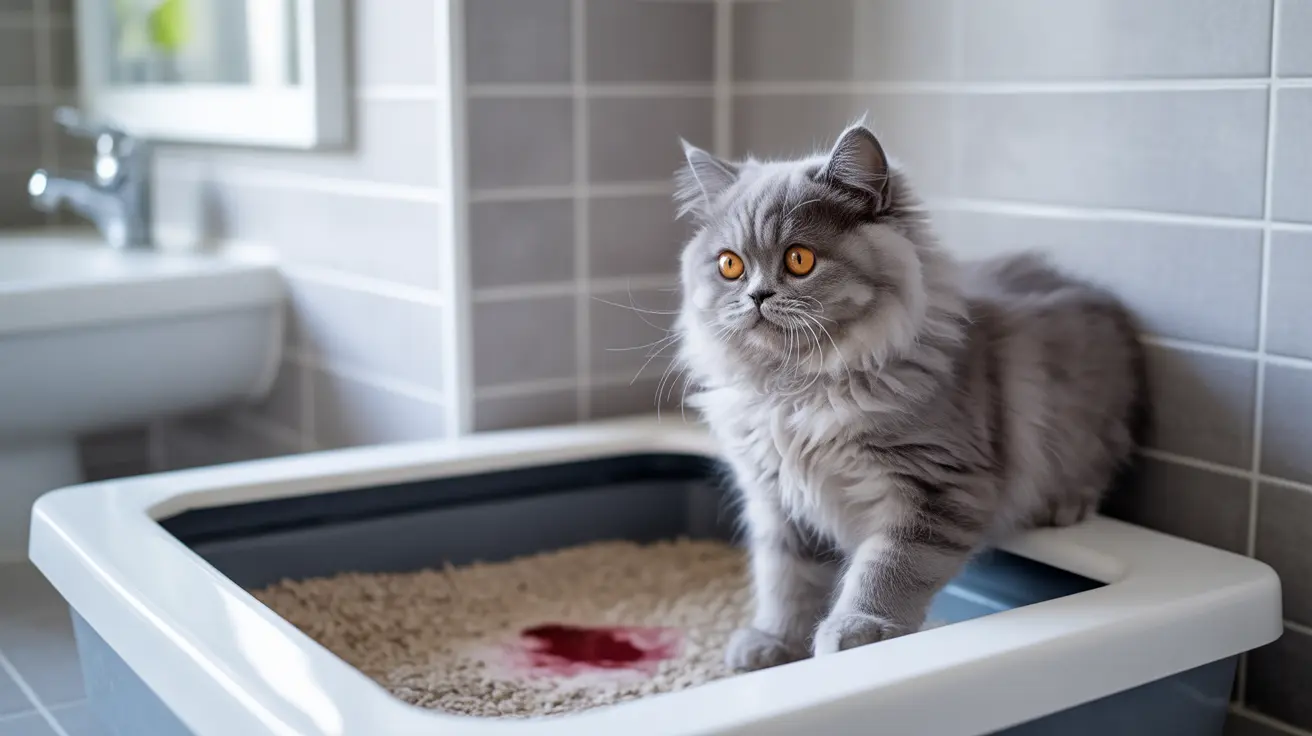When it comes to monitoring your cat's health, paying attention to their stool can provide crucial insights into their overall well-being. Blood in cat stool is a concerning symptom that should never be ignored, as it can indicate various underlying health issues ranging from minor digestive upset to serious medical conditions.
Understanding what normal cat stool looks like is essential for detecting problems early. Healthy cat stool should be firm but not hard, well-formed, and brown or dark brown in color, without any offensive odor. Any deviation from these characteristics, especially the presence of blood, warrants careful attention and potentially veterinary intervention.
This comprehensive guide will help you understand the various aspects of feline digestive bleeding, including recognition, causes, diagnosis, and treatment options, ensuring you're well-equipped to handle this serious health concern.
Types of Bloody Stool in Cats
Identifying Different Forms of Blood
Blood in a cat’s stool can manifest in different ways, each providing clues about the potential source and severity of the issue. Recognizing the type of bloody stool is crucial for determining the underlying cause and the urgency of veterinary care.
- Melena (Black, Tarry Stools): This form of stool is dark and tar-like, indicating the presence of digested blood originating from bleeding higher up in the digestive tract, such as the stomach or small intestine. Melena often suggests a more serious internal problem and warrants prompt veterinary attention.
- Bright Red Blood: Fresh, red blood in or on the stool typically points to bleeding in the lower intestinal tract, rectum, or anus. This may be caused by minor issues like anal gland irritation or more significant concerns like colitis or polyps.
- Blood with Mucus: When blood is mixed with mucus, it is often a sign of inflammation in the colon, such as colitis. This combination can arise from infections, food intolerance, or chronic digestive diseases.
When to Seek Emergency Care
While mild or isolated instances of blood in your cat’s stool may not always constitute an emergency, certain symptoms accompanying bloody stool are red flags for urgent veterinary care. Immediate professional attention is necessary if you notice:
- Significant or continuous blood loss, as it may quickly lead to anemia and shock.
- Pale, bluish, or discolored gums, indicating possible poor blood circulation or acute blood loss.
- Severe or persistent diarrhea, especially when accompanied by other symptoms or if your cat becomes dehydrated.
- Repeated vomiting, which could signal systemic illness or poisoning.
- Lethargy, general weakness, or collapse, all of which are signs of potentially life-threatening conditions.
If any combination of these symptoms is observed, do not delay in seeking veterinary care to increase the chances of a positive outcome.
Common Causes of Bloody Stool
Medical Conditions
Several medical conditions can contribute to the presence of blood in a cat's stool. Understanding these potential culprits helps guide appropriate diagnosis and treatment:
- Intestinal parasites: Worms such as hookworms, roundworms, and other parasites are frequent causes of bleeding in the intestines, particularly in kittens and outdoor cats.
- Feline inflammatory bowel disease (IBD): Chronic inflammation in the digestive tract often results in ongoing bleeding and gastrointestinal symptoms.
- Food allergies: Allergic reactions to certain proteins or additives can irritate the intestines, leading to bleeding.
- Foreign body ingestion: Swallowing non-food items can damage the digestive lining, causing bleeding and potential blockages.
- Infections or toxins: Bacterial, viral, or fungal infections, as well as exposure to toxic substances, may harm the digestive tract's delicate tissues.
- Cancer: Digestive tract tumors can erode blood vessels, resulting in persistent bleeding that presents as blood in the stool.
Digestive System Issues
Other digestive problems can lead directly to bloody stool in cats, including:
- Colon bleeding: Conditions like colitis or polyps affect the colon, causing localized bleeding.
- Constipation: Hard or dry stools may cause small tears in the anus or colon, producing streaks of blood.
- Inflammatory conditions: Chronic inflammation, whether from infections, allergies, or autoimmune responses, often contributes to recurring blood in the stool.
- Bacterial imbalances: Disruption of the normal gut microbiome can upset digestion and result in inflammation, diarrhea, and bloody stools.
Diagnostic Process
Pinpointing the cause of blood in a cat’s stool involves a thorough diagnostic process conducted by your veterinarian. The steps may include:
- Comprehensive history review: Sharing detailed information about your cat's diet, lifestyle, recent exposures, and symptom duration helps guide diagnosis.
- Physical examination: A hands-on assessment allows the vet to detect abdominal pain, masses, dehydration, or other abnormalities.
- Fecal testing: Laboratory analysis of a stool sample checks for parasites, bacteria, or underlying infections.
- Blood work: Blood tests evaluate signs of anemia, infection, or organ dysfunction that could relate to the bleeding.
- Imaging studies: X-rays or ultrasounds help visualize foreign bodies, tumors, and internal organ health.
- Specialized testing: If the above tests are inconclusive, the veterinarian may recommend endoscopy, biopsies, or additional laboratory work to uncover less common causes.
Treatment Approaches
The appropriate treatment for blood in cat stool depends on what is causing the symptom. Treatment plans may include one or more of the following strategies:
- Fluid therapy: Especially important if your cat is dehydrated from diarrhea or vomiting.
- Medication administration: Includes antibiotics for infections, anti-parasitics, anti-inflammatories, or other targeted drugs as needed.
- Dietary modifications: Switching to a hypoallergenic, high-fiber, or easily digestible diet can aid recovery and reduce irritation.
- Surgical intervention: Required in cases of foreign body obstruction, tumors, or severe polyps that cannot be managed medically.
- Parasite treatment: Dewormers and medications eliminate parasitic infections contributing to gastrointestinal bleeding.
- Supportive care: May include appetite stimulants, probiotics, pain relief, or supplemental nutrition as appropriate to your cat's condition.
Veterinary follow-up and continued monitoring of stool characteristics are essential to track progress and adjust treatments as necessary.
Prevention Strategies
Taking proactive steps can reduce your cat’s risk of experiencing bloody stool and other digestive issues. Consider incorporating the following strategies into your cat’s care routine:
- Regular parasite prevention: Consistently administer veterinarian-recommended dewormers and flea preventatives suited to your cat’s lifestyle.
- High-quality diet: Offer nutritionally complete, age-appropriate food to maintain digestive health and reduce the risk of allergic reactions or sensitivities.
- Routine health checkups: Schedule veterinary visits at least annually, or more frequently for senior cats or those with ongoing health problems.
- Monitor stool consistency and color: Regularly inspect your cat's litter box for changes in stool appearance that could indicate developing health issues.
- Stress management: Create a stable, calm home environment; minimize changes to routine and offer safe spaces to help your cat cope with stressors that might otherwise cause digestive upset.
Frequently Asked Questions
- What does blood in my cat's stool mean? Blood in cat stool can indicate digestive inflammation, parasites, allergies, injuries, or serious diseases. It's important to identify any additional symptoms and seek veterinary advice.
- Is blood in cat stool an emergency? If the blood is recurring or accompanied by other alarming signs like vomiting, diarrhea, weakness, or pale gums, it should be treated as an emergency and you should contact your veterinarian immediately.
- What are the most common causes of bloody stool in cats? The most frequent causes are intestinal parasites, inflammatory bowel disease, food allergies, ingestion of foreign objects, and cancer affecting the digestive system.
- Can food changes cause blood in cat stool? Yes. Sudden changes in diet, new foods, or food intolerances can disturb a cat's digestive tract, sometimes resulting in mild bleeding. Always introduce new foods gradually and monitor for any adverse reactions.
- How is the cause of blood in cat stool diagnosed? Diagnosis may require fecal tests for parasites, blood tests, imaging studies, and a thorough history. Your veterinarian will use this information to narrow down the potential underlying conditions.
- What treatments are used for blood in cat feces? Treatments vary and may include medication (such as antibiotics or dewormers), dietary changes, hydration support, or in some cases, surgery. The specific treatment will depend on the diagnosed cause.
- Can indoor cats get blood in stool from parasites? Yes. Parasites can be introduced through contact with contaminated food, water, or people. Even strictly indoor cats are at risk, making regular prevention crucial.
- What does black stool mean in cats? Black, tarry stool (melena) suggests bleeding from higher up in the gastrointestinal system, which is considered more serious and warrants immediate veterinary evaluation.
- Should I change my cat's diet if I see blood in the stool? Do not change your cat’s diet without consulting a veterinarian. Dietary changes may help or hinder recovery, depending on the underlying issue.
- How can I prevent blood appearing in my cat's stool? Maintain regular parasite control, feed high-quality food, monitor for any sudden stool changes, and ensure your cat receives timely checkups.
Monitoring your cat's stool health is a crucial aspect of responsible pet ownership. By staying vigilant and responding promptly to any changes, particularly the presence of blood, you can help ensure your cat receives timely medical attention when needed. Remember that early intervention often leads to better outcomes in treating cat health warning signs.






